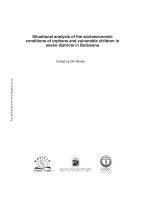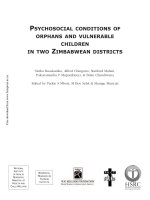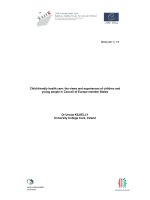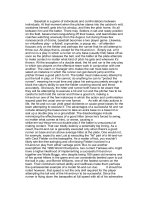Context-dependent interpretation of the prognostic value of BRAF and KRAS mutations in colorectal cancer
Bạn đang xem bản rút gọn của tài liệu. Xem và tải ngay bản đầy đủ của tài liệu tại đây (730.01 KB, 7 trang )
Popovici et al. BMC Cancer 2013, 13:439
/>
RESEARCH ARTICLE
Open Access
Context-dependent interpretation of the
prognostic value of BRAF and KRAS mutations in
colorectal cancer
Vlad Popovici1,2*, Eva Budinska1,2, Fred T Bosman3, Sabine Tejpar4, Arnaud D Roth5 and Mauro Delorenzi2,6
Abstract
Background: The mutation status of the BRAF and KRAS genes has been proposed as prognostic biomarker in
colorectal cancer. Of them, only the BRAF V600E mutation has been validated independently as prognostic for
overall survival and survival after relapse, while the prognostic value of KRAS mutation is still unclear. We
investigated the prognostic value of BRAF and KRAS mutations in various contexts defined by stratifications of the
patient population.
Methods: We retrospectively analyzed a cohort of patients with stage II and III colorectal cancer from the PETACC-3
clinical trial (N = 1,423), by assessing the prognostic value of the BRAF and KRAS mutations in subpopulations
defined by all possible combinations of the following clinico-pathological variables: T stage, N stage, tumor site,
tumor grade and microsatellite instability status. In each such subpopulation, the prognostic value was assessed by
log rank test for three endpoints: overall survival, relapse-free survival, and survival after relapse. The significance
level was set to 0.01 for Bonferroni-adjusted p-values, and a second threshold for a trend towards statistical
significance was set at 0.05 for unadjusted p-values. The significance of the interactions was tested by Wald test,
with significance level of 0.05.
Results: In stage II-III colorectal cancer, BRAF mutation was confirmed a marker of poor survival only in
subpopulations involving microsatellite stable and left-sided tumors, with higher effects than in the whole
population. There was no evidence for prognostic value in microsatellite instable or right-sided tumor groups. We
found that BRAF was also prognostic for relapse-free survival in some subpopulations. We found no evidence that
KRAS mutations had prognostic value, although a trend was observed in some stratifications. We also show
evidence of heterogeneity in survival of patients with BRAF V600E mutation.
Conclusions: The BRAF mutation represents an additional risk factor only in some subpopulations of colorectal
cancers, in others having limited prognostic value. However, in the subpopulations where it is prognostic, it
represents a marker of much higher risk than previously considered. KRAS mutation status does not seem to
represent a strong prognostic variable.
Keywords: Colorectal cancer, BRAF V600E mutation, KRAS mutations, Survival analysis, Stratified analysis
* Correspondence:
1
Institute of Biostatistics and Analyses, Masaryk University, Kotlarska 2, 611 37
Brno, Czech Republic
2
Bioinformatics Core Facility, Swiss Institute of Bioinformatics, Lausanne,
Switzerland
Full list of author information is available at the end of the article
© 2013 Popovici et al.; licensee BioMed Central Ltd. This is an Open Access article distributed under the terms of the Creative
Commons Attribution License ( which permits unrestricted use, distribution, and
reproduction in any medium, provided the original work is properly cited.
Popovici et al. BMC Cancer 2013, 13:439
/>
Background
Our current models of colorectal cancer (CRC) are dominated by the idea of a sequential tumor progression from
adenoma to carcinoma, in which the accumulation of genetic events in key genes defines alternative oncogenic
paths with impact on tumor characteristics. These genetic
events include the mutational activation of oncogenes like
BRAF and KRAS, disruption of WNT signaling, allelic imbalance on chromosome 18q and mutation of TP53 tumor
suppressor gene [1-4]. Since the mutations of BRAF and
KRAS genes, which lead to the activation of MEK/ERK
pathway, are seen as important events in the tumor progression and based on their relatively high incidence (715% for BRAF mutations and 35-40% for KRAS mutations
[5-8]), they have been proposed as prognostic biomarkers
for CRC. Of them, only BRAF V600E mutation has been
consistently validated, while the prognostic value of KRAS
mutation remains debatable. The BRAF has been shown
to be prognostic for overall survival (OS) and survival after
relapse (SAR) in general CRC population by us and others
[9-13] as well as in microsatellite-stable (MSS) population
[12,14], while having no prognostic value for relapse-free
survival (RFS). In these studies, the hazard ratios (HR) for
BRAF mutation varied between 1.4 and 2.1 for OS and 2.3
to 3.6 for SAR. In the case of KRAS mutation, the published results are contradictory, with prognostic value, in
the positive studies, found only for relapse-free survival
[9,11,15], while other studies, including our own [13], did
not find any evidence of prognostic value for KRAS mutation. Also, a recent meta-analytical review found no evidence supporting the prognostic value of KRAS mutation
[16]. A detailed review is given in [17].
The question remains whether the prognostic value of
the BRAF and KRAS mutations is uniform across different
patient groups defined by clinical parameters or if there
are interactions that would influence their utility. Taking
advantage of a large series of stage II-III CRC tumors with
mutation data from the PETACC-3 clinical trial [18], we
systematically investigate the prognostic value of the
BRAF and KRAS mutations in all possible stratifications –
contexts – defined by a set of clinical parameters found to
be important in survival prognosis in a previous analysis
[19]. The main question our study tries to answer is
whether the mutations of BRAF and KRAS genes are indicators of different prognosis within otherwise uniform
(with respect to the clinical parameters considered) subpopulations of patients with CRC. A secondary question
we address, for the main findings, is whether the observed
prognostic values are statistically significant also in multivariate models, in the respective subpopulations.
Methods
We retrospectively analyzed the PETACC-3 clinical trial
[18] data set (N = 1,423), of patients with stage II and III
Page 2 of 7
CRC, by generating the subpopulations defined by all
possible combinations of levels of the following five variables: MSI status (MSI-H and MSS levels), tumor site (left
and right), T stage (T1,2, T3, and T4), N stage (N0, N1
and N2) and tumor grade (G1,2 and G3,4). In total, there
were 393 possible subpopulations (see Additional file 1 for
an exhaustive listing), of which only those with more than
N = 20 samples were further considered for testing the
prognostic value of the BRAF and KRAS mutations. The
full description of the data set is given in [19].
In each subpopulation, the prognostic importance of the
BRAF and KRAS mutations was assessed using log-rank
test comparing the survival of BRAF-/KRAS-mutant
population to the BRAF- and KRAS- wild type (double
wild type – WT2) population, for overall survival (OS),
relapse-free survival (RFS) and survival after relapse (SAR)
endpoints. Data was summarized with hazard ratios (HR),
their 95% confidence intervals (CI), P-values and adjusted
P-values (Bonferonni correction, denoted hereinafter
by P*). For a result to be considered statistically significant we required that P* ≤ 0.01 and that at least 10
patients were in each of the two groups compared. If
only P ≤ 0.05, the result was reported as a trend towards
significance. The significance of the interactions was tested
by Wald test in the presence of both main effects, with
significance level of 0.05 (no adjustment for multiple testing in this case). All tests were two-sided.
All computations were carried out in R version 2.15.2
() and survival analysis was performed
using R survival package version 2.37-2.
Results and discussion
In the global population, the BRAF mutation is prognostic
for poorer overall survival and survival after relapse, while
KRAS mutation is not prognostic for any of the three endpoints (Table 1). In stratified analyses and after correction
for multiple testing, BRAF mutation status remained a
significant prognostic marker in various subpopulations.
On the contrary, KRAS mutation status never reached the
level of significance required after P-value adjustment
(P* ≤ 0.01 and at least 10 patients in both of the groups
compared). However, in several stratifications, KRAS
mutation showed a trend towards significance (P ≤ 0.05).
The full table of results with all possible stratifications is
given as Additional file 1.
BRAF mutation
The BRAF mutation was prognostic for overall survival in
MSS and/or left-sided tumors subpopulations (Figure 1).
In the MSS tumors, BRAF was indicative of worse overall
survival (P* < 0.0001; HR = 2.82; 95% CI = 1.85 to 4.30), as
well as in MSS/left tumors (P* < 0.0001; HR = 6.41; 95%
CI = 3.57 to 11.52) and all left-sided tumors (P* < 0.0001;
HR = 5.18; 95% CI = 3.00 to 8.94) (Figure 1A,B). At the
Popovici et al. BMC Cancer 2013, 13:439
/>
Page 3 of 7
Table 1 Univariate analysis of the prognostic factors in the whole CRC population
OS
Factor
Comparison
P-value
SAR
P-value
HR (95% CI)
P-value
0.45 (0.30,0.69)
< 0.0001
0.48 (0.34,0.68)
0.9643
0.99 (0.65,1.52)
HR (95% CI)
MSI
MSI-H vs MSS
Site
Left vs Right
0.3143
0.89 (0.72,1.11)
0.2123
1.13 (0.93,1.36)
<0.0001
0.59 (0.47, 0.73)
Grade
G3,4 vs G1,2
0.0018
1.63 (1.29,2.23)
0.0012
1.56 (1.19,2.04)
0.0387
1.38 (1.01,1.88)
T stage
N stage
BRAF
KRAS
0.0002
RFS
HR (95% CI)
T3 vs T1,2
0.0634
1.76 (0.96,3.22)
0.0629
1.58 (0.97,2.58)
0.1399
1.57 (0.86,2.88)
T4 vs T1,2
0.0002
3.06 (1.63,5.74)
< 0.0001
2.69 (1.61,4.48)
0.0680
1.78 (0.95,3.35)
N1 vs N0
< 0.0001
1.91 (1.38,2.65)
< 0.0001
1.78 (1.36, 2.32)
0.9809
0.98 (0.71,1.35)
N2 vs N0
< 0.0001
4.51 (3.28,6.21)
< 0.0001
4.06 (3.11,5.29)
0.1498
1.24 (0.90,1.71)
BRAF mut vs WT2
0.0004
1.92 (1.33,2.78)
0.0832
1.35 (0.96,1.89)
< 0.0001
2.56 (1.75,3.70)
BRAF mut vs BRAF wt
0.0009
1.78 (1.26,2.53)
0.1174
1.30 (0.94,1.81)
< 0.0001
2.48 (1.74,3.53)
KRAS mut vs WT2
0.1461
1.20 (0.93,1.54)
0.4410
1.09 (0.88,1.33)
0.1755
1.18 (0.93,1.52)
KRAS mut vs KRAS wt
0.4826
1.09 (0.86,1.37)
0.7245
1.04 (0.85,1.27)
0.7222
1.04 (0.82,1.32)
same time, BRAF mutation was not prognostic in any
stratification involving only right-sided tumors (Figure 1C)
and/or MSI-H tumors. In a multivariate model, including
up to second degree interactions between MSI status,
BRAF mutation and tumor site, adjusted for grade, T stage
and N stage, the only significant interaction was between
BRAF mutation and tumor site (P = 0.0041). The interaction between BRAF mutation status and tumor site was
also significant within MSS tumors (P = 0.0033), but not
within MSI-H tumors. The interaction between BRAF
mutation status and MSI status was not significant in
either left or right-sided tumors. These results show that
BRAF mutation represents an additional risk factor only
within MSS/left tumors, with no statistically significant
effect in right or MSI-H tumors, the general prognostic
value of BRAF mutation being driven by its effect in this
subpopulation. As a consequence, the corresponding HR
should be re-interpreted: a BRAF mutation does not
double the risk of death for all patients carrying this
mutation (HR = 1.92 in global population), but represents
a six-fold increase of the risk in the case of patients with
MSS/left tumors (HR = 6.41) – in comparison with the
double wild type MSS/left tumors. At the same time,
BRAF mutation does not significantly influence the risk of
death (in comparison with WT2) in MSI-H and/or rightsided tumors. The MSS/left side BRAF-mutant population
emerges as the worst surviving group of patients in our
data set: for example, the 3-year overall survival rate is
0.35 (95% CI = 0.20 to 0.66) in comparison to 0.89
(95% CI = 0.85 to 0.93) for KRAS-mutant and 0.91
(95% CI = 0.88 to 0.93) for WT2, respectively (Table 2).
The observation could not be extended to MSS/rightsided tumors (Table 2).
Interestingly, BRAF mutation was also prognostic for
shorter relapse-free survival in left-sided tumors (Figure 2):
all left-sided tumors (P* = 0.0002; HR = 3.31; 95% CI = 1.98
to 5.55) and MSS/left tumors (P* = 0.0005; HR = 3.57;
95% CI = 2.02 to 6.31) (Figure 2, see also Table 2). This
Figure 1 Overall survival: prognostic value of BRAF and KRAS mutations within MSS and by tumor site. A: all MSS tumors; B: MSS leftsided tumors; C: MSS right-sided tumors. The light gray survival curve represents the whole subpopulation survival (A: all MSS, B: MSS left-sided,
C: MSS right-sided tumors).
Popovici et al. BMC Cancer 2013, 13:439
/>
Page 4 of 7
Table 2 Three-year overall and relapse-free survival rates,
and one-year survival after relapse rates in MSS/left and
MSS/right populations, stratified by mutation status
MSS/left
Population
Survival rate
MSS/right
95% CI
Survival rate
95% CI
OS: 3-year survival rates
WT2
0.91
0.88-0.93
0.83
0.77-0.89
KRAS mut
0.89
0.85-0.93
0.80
0.74-0.86
BRAF mut
0.37
0.20-0.66
0.73
0.60-0.89
0.75
0.68-0.82
RFS: 3-year survival rates
WT2
0.75
0.71-0.80
KRAS mut
0.68
0.62-0.74
0.73
0.66-0.80
BRAF mut
0.32
0.16-0.61
0.68
0.54-0.84
0.65
0.52-0.82
SAR: 1-year survival rates
WT2
0.81
0.74-0.88
KRAS mut
0.80
0.71-0.89
0.75
0.53-0.80
BRAF mut
0.17
0.05-0.60
0.36
0.17-0.79
is a novel observation, since BRAF mutation was not
generally considered prognostic for relapse. In other
MSS-subpopulations involving left-sided tumors BRAF
mutation is also prognostic (see Additional file 1).
Again, the BRAF mutation was not prognostic in any
subpopulation involving MSI-H and/or right-sided tumors. In a multivariate model, involving up to second
degree interactions between MSI status, BRAF mutation
and tumor site, adjusted for grade, T stage and N stage,
the only significant interaction was between BRAF
mutation and tumor site (P = 0.047). The interaction
between BRAF mutation status and tumor site was also
significant within MSS tumors (P = 0.043), but not within
MSI-H tumors (where the small number of BRAF mutants
in the left colon limits the statistical power). Hence, the
prognostic value of the BRAF mutation is confined to the
MSS/left-sided tumors.
For the survival after relapse (SAR), BRAF mutation represents an additional risk factor in more stratifications,
most of them involving MSS and/or left-sided tumors.
BRAF mutation shows also a trend to be prognostic in
MSS/right-sided tumors as well, even though the p-value
was no longer significant after multiple testing correction.
The BRAF mutation was indicative of poor survival
after relapse in all MSS tumors (P* < 0.0001; HR = 3.43;
95% CI = 2.19 to 5.36); MSS/left tumors (P* = 0.0002;
HR = 3.89; 95% CI = 2.11 to 7.20) and showed a trend in
MSS/right (P = 0.0111; HR = 2.27; 95% CI = 1.17 to 4.38)
(Figure 3). The test for interaction between BRAF mutation status and tumor site was not significant, hence we
conclude that BRAF mutation is prognostic for SAR in
all MSS patients.
The differences in prognostic value of the BRAF mutation status in various subpopulations suggest a certain
degree of heterogeneity in the survival of patients harboring this mutation. Indeed, within the BRAF mutant
population, the MSS tumors had worse outcome for
overall survival (P = 0.0021; HR = 3.45; 95% CI = 1.49 to
7.69)) and relapse-free survival (P = 0.0085; HR = 2.63;
95% CI = 1.25 to 5.56), this observation being in line
with the fact that MSI-H has a protective prognostic effect
in CRC. At the same time, the left BRAF-mutant tumors
had a worse prognosis than the right BRAF-mutant
tumors, for overall survival (within all BRAF-mutants:
P = 0.0003; HR = 3.20; 95% CI = 1.64 to 6.23; within MSS/
BRAF-mutants: P = 0.0059; HR = 2.84; 95% CI = 1.31 to
6.15; while within MSI-H/BRAF-mutants it could not be
assessed) and for relapse-free survival (within all BRAFmutants: P = 0.0002; HR = 3.24; 95% CI = 1.71 to 6.16;
within MSS/BRAF-mutants: P = 0.0062; HR = 2.82; 95%
Figure 2 Relapse-free survival: prognostic value of BRAF and KRAS in left-sided tumors. A: all left-sided tumors; B: MSS left-sided tumors.
The light gray survival curve represents the whole subpopulation survival (A: all left tumors; B: MSS left).
Popovici et al. BMC Cancer 2013, 13:439
/>
Page 5 of 7
Figure 3 Survival after relapse: prognostic value of BRAF and KRAS mutations in MSS tumors by site. A: all MSS tumors; B: MSS left-sided
tumors; C: MSS right-sided tumors. The light gray survival curve represents the whole subpopulation survival (A: all MSS, B: MSS left-sided, C: MSS
right-sided tumors).
CI = 1.30 to 6.12; while within MSI-H/BRAF-mutants it
could not be assessed). However, there was no statistically
significant difference in survival after relapse among BRAF
mutants, all having an equally poor survival.
KRAS mutation
KRAS mutation did not reach the significance level
required to be considered prognostic for any of the three
endpoints, since the adjusted p-values were all larger than
0.01. However, in some cases, it showed a trend towards
significance (P ≤ 0.05).
In overall survival, KRAS mutation had a trend to become significant in several stratifications of tumors with
early stage lymph node invasion (N1). In all these, KRAS
mutation was a marker of worse outcome (see Additional
file 1). While not being a significant prognostic factor (as
required by us) for relapse-free survival, KRAS mutation
showed a trend to become prognostic. In contrast with
BRAF, KRAS mutation seemed to be prognostic for RFS
mostly in the right colon. The most intriguing observation
was in MSI-H/right colon subpopulation (N = 102, KRAS
mutants: 39), where KRAS mutation seemed to identify
a low risk group (P = 0.0349; HR = 0.29; 95% CI = 0.08
to 0.99) (Figure 4). KRAS mutation was not prognostic
for SAR. Also, no significant interaction between KRAS
mutation, MSI status and tumor site was observed, for
any of the three endpoints.
Since several studies have suggested that KRAS mutations at codon 12 may have a different prognostic value
than codon 13 mutations [20], we have tested for differences in survival between the two groups of mutations,
in all the same stratifications. No statistically significant
difference was observed, but the sample size of our data
might be too limited to detect such differences.
Figure 4 Relapse-free survival: prognostic value of BRAF and KRAS in MSI-H tumors by site. A: all MSI-H tumors; B: MSI-H left-sided
tumors; C: MSI-H right-sided tumors. The light gray survival curve represents the whole subpopulation survival (A: all MSI-H, B: MSI-H left-sided,
C: MSI-H right-sided tumors).
Popovici et al. BMC Cancer 2013, 13:439
/>
Conclusions
In our analyses, we have compared the survival of BRAF/
KRAS-mutated population with that of the double-wild
type population, while controlling for several other parameters (tumor site, T and N stage, grade and MSI status).
Our analyses confirm the prognostic value of BRAF
mutation status, in various stratifications. As a novelty,
we observe a strong prognostic value for relapse-free
survival of the BRAF mutation status in the MSS/leftcolon tumors.
The interpretation of BRAF mutation as additional
risk factor has to be made in the context of MSI status
and tumor location. Indeed, our results show that BRAF
represents a risk factor in the left colon and/or MSS
tumors. In the data analyzed, we found no sufficient
statistical evidence supporting a worse outcome associated with BRAF mutation in MSI-H tumors. As a consequence, the published hazard ratios for BRAF mutation
for general population have to be reconsidered. The tumor
staging (T or N stage, tumor grade) had a lesser impact on
the prognostic value of the BRAF mutation status, while
the tumor background (site and microsatellite (in)stability)
significantly influenced the prognostic.
For the KRAS mutation, we could not confirm nor completely disprove its prognostic value. It was prognostic in
several stratifications, in some showing a protective effect,
while in others representing a risk factor. This is probably
an effect of the heterogeneity of KRAS mutant population
[21,22] and may explain in part the contradictory results
published so far. With the strict requirements for statistical significance imposed, KRAS mutation did not appear
to have prognostic value in any of the stratifications. The
trend towards significance suggests, however, a potential
utility as prognostic marker for RFS mostly in right colon.
In conclusion, the utility of the BRAF and KRAS as
prognostic biomarkers depends on the MSI status and
tumor location. We hypothesize that this interaction
may extend to other biomarkers and prognostic gene
signatures as well. At the same time, this observation
has clear implications in clinical trial design and needs
to be accounted for.
We make public the full table with all stratifications to
support similar analyses in other data sets.
Additional file
Additional file 1: Full survival analysis results. In each possible
stratification three endpoints were tested - overall survival, relapse-free
survival and survival after relapse - and the sample size of the analysis
along with the resulting p-values and hazard ratios are given.
Abbreviations
MSI: Microsatellite instability; MSI-H: High microsatellite instability;
MSS: Microsatellite stable; OS: Overall survival; RFS: Relapse-free survival;
Page 6 of 7
SAR: Survival after relapse; WT2: Double wild type tumors: tumors that are
BRAF- and KRAS-wild type.
Competing interests
The authors declare that they have no competing interests.
Authors’ contributions
VP conceived and designed the investigation, performed the statistical
analyses, interpreted the results and drafted the manuscript. EB performed
statistical analyses and drafted the manuscript. FB, ST, AR and MD
participated in data generation, result interpretation and contributed to
manuscript drafting. All authors have read and approved the final
manuscript.
Acknowledgments
ST is a Senior Clinical Investigator of the Fund for Scientific Research Flanders
(FWO-Vlaanderen) and has received research grants from the Belgian
Federation against Cancer (Stichting tegen Kanker) and from the Belgian
National Cancer Plan (Nationaal Kankerplan). This work was supported by the
grants SNF 320030_135421 of the Swiss National Science Foundation and
KFS 0269708-2010 of the Krebsliga Schweiz to AR and MD and by the EU
Seventh Framework Programme, grant agreement 259015 to MD.
Author details
1
Institute of Biostatistics and Analyses, Masaryk University, Kotlarska 2, 611 37
Brno, Czech Republic. 2Bioinformatics Core Facility, Swiss Institute of
Bioinformatics, Lausanne, Switzerland. 3Institute of Pathology, Lausanne
University Medical Center, Lausanne, Switzerland. 4University Hospital
Gasthuisberg, Katholieke Universiteit Leuven, Leuven, Belgium. 5Oncosurgery
Unit, Geneva University Hospital, Geneva, Switzerland. 6University of
Lausanne, Lausanne, Switzerland.
Received: 13 May 2013 Accepted: 24 September 2013
Published: 27 September 2013
References
1. Vogelstein B, Fearon ER, Hamilton SR, Kern SE, Preisinger AC, Leppert M,
Nakamura Y, White R, Smits AM, Bos JL: Genetic alterations during
colorectal-tumor development. N Engl J Med 1988, 319:525–532.
2. Vogelstein B, Fearon ER, Kern SE, Hamilton SR, Preisinger AC, Nakamura Y,
White R: Allelotype of colorectal carcinomas. Science 1989, 244:207–211.
3. Markowitz SD, Bertagnolli MM: Molecular origins of cancer: Molecular
basis of colorectal cancer. N Engl J Med 2009, 361:2449–2460.
4. Segditsas S, Tomlinson I: Colorectal cancer and genetic alterations in the
Wnt pathway. Oncogene 2006, 25:7531–7537.
5. Samowitz WS, Sweeney C, Herrick J, Albertsen H, Levin TR, Murtaugh MA,
Wolff RK, Slattery ML: Poor survival associated with the BRAF V600E
mutation in microsatellite-stable colon cancers. Cancer Res 2005,
65:6063–6069.
6. Nosho K, Irahara N, Shima K, Kure S, Kirkner GJ, Schernhammer ES, Hazra A,
Hunter DJ, Quackenbush J, Spiegelman D, Giovannucci EL, Fuchs CS, Ogino
S: Comprehensive biostatistical analysis of CpG island methylator
phenotype in colorectal cancer using a large population-based sample.
PLoS One 2008, 3:e3698.
7. Brink M, de Goeij AF, Weijenberg MP, Roemen GM, Lentjes MH, Pachen MM,
Smits KM, de Bruine AP, Goldbohm RA, van den Brandt PA: K-ras oncogene
mutations in sporadic colorectal cancer in The Netherlands Cohort
Study. Carcinogenesis 2003, 24:703–710.
8. English DR, Young JP, Simpson JA, Jenkins MA, Southey MC, Walsh MD,
Buchanan DD, Barker MA, Haydon AM, Royce SG, Roberts A, Parry S, Hopper
JL, Jass JJ, Giles GG: Ethnicity and risk for colorectal cancers showing
somatic BRAF V600E mutation or CpG island methylator phenotype.
Cancer Epidemiol Biomarkers Prev 2008, 17:1774–1780.
9. Fariña-Sarasqueta A, van Lijnschoten G, Moerland E, Creemers GJ, Lemmens
VEPP, Rutten HJT, van den Brule AJC: The BRAF V600E mutation is an
independent prognostic factor for survival in stage II and stage III colon
cancer patients. Ann Oncol 2010, 21:2396–2402.
10. Gavin PG, Colangelo LH, Fumagalli D, Tanaka N, Remillard MY, Yothers G,
Kim C, Taniyama Y, Kim SI, Choi HJ, Blackmon NL, Lipchik C, Petrelli NJ,
O'Connell MJ, Wolmark N, Paik S, Pogue-Geile KL: Mutation Profiling and
Microsatellite Instability in Stage II and III Colon Cancer: An Assessment
Popovici et al. BMC Cancer 2013, 13:439
/>
11.
12.
13.
14.
15.
16.
17.
18.
19.
20.
21.
22.
of Their Prognostic and Oxaliplatin Predictive Value. Clin Cancer Res 2012,
18:6531–6541.
Nakanishi R, Harada J, Tuul M, Zhao Y, Ando K, Saeki H, Oki E, Ohga T, Kitao
H, Kakeji Y, Maehara Y: Prognostic relevance of KRAS and BRAF mutations
in Japanese patients with colorectal cancer. Int J Clin Oncol 2012:1–7.
/>Ogino S, Shima K, Meyerhardt JA, McCleary NJ, Ng K, Hollis D, Saltz LB,
Mayer RJ, Schaefer P, Whittom R, Hantel A, Benson AB, Spiegelman D,
Goldberg RM, Bertagnolli MM, Fuchs CS: Predictive and prognostic roles of
BRAF mutation in stage III colon cancer: results from intergroup trial
CALGB 89803. Clin Cancer Res 2012, 18:890–900.
Roth AD, Tejpar S, Delorenzi M, Yan P, Fiocca R, Klingbiel D, Dietrich D,
Biesmans B, Bodoky G, Barone C, Aranda E, Nordlinger B, Cisar L, Labianca R,
Cunningham D, Van Cutsem E, Bosman F: Prognostic role of KRAS and
BRAF in stage II and III resected colon cancer: results of the translational
study on the PETACC-3, EORTC 40993, SAKK 60-00 trial. J Clin Oncol 2010,
28:466–474.
Pai RK, Jayachandran P, Koong AC, Chang DT, Kwok S, Ma L, Arber DA,
Balise RR, Tubbs RR, Shadrach B, Pai RK: BRAF-mutated, microsatellitestable adenocarcinoma of the proximal colon: an aggressive
adenocarcinoma with poor survival, mucinous differentiation, and
adverse morphologic features. Am J Surg Pathol 2012, 36:744–752.
Hutchins G, Southward K, Handley K, Magill L, Beaumont C, Stahlschmidt J,
Richman S, Chambers P, Seymour M, Kerr D, Gray R, Quirke P: Value of
mismatch repair, KRAS, and BRAF mutations in predicting recurrence
and benefits from chemotherapy in colorectal cancer. J Clin Oncol 2011,
29:1261–1270.
Ren J, Li G, Ge J, Li X, Zhao Y: Is K-ras gene mutation a prognostic factor
for colorectal cancer: a systematic review and meta-analysis. Dis Colon
Rectum 2012, 55:913–923.
Tejpar S, Bertagnolli MM, Bosman F, Lenz HJ, Garraway L, Waldman F,
Warren R, Bild A, Collins-Brennan D, Hahn H, Harkin DP, Kennedy R, Ilyas M,
Morreau H, Proutski V, Swanton C, Tomlinson I, Delorenzi M, Fiocca R, Van
Cutsem E, Roth A: Prognostic and predictive biomarkers in resected
colon cancer: current status and future perspectives for integrating
genomics into biomarker discovery. Oncologist 2010, 15:390–404.
Van Cutsem E, Labianca R, Bodoky G, Barone C, Aranda E, Nordlinger B,
Topham C, Tabernero J, Andre T, Sobrero AF, Mini E, Greil R, Di Costanzo F,
Collette L, Cisar L, Zhang X, Khayat D, Bokemeyer C, Roth AD, Cunningham
D: Randomized phase III trial comparing biweekly infusional fluorouracil/
leucovorin alone or with irinotecan in the adjuvant treatment of stage III
colon cancer: PETACC-3. J Clin Oncol 2009, 27:3117–3125.
Roth AD, Delorenzi M, Tejpar S, Yan P, Klingbiel D, Fiocca R, d'Ario G, Cisar L,
Labianca R, Cunningham D, Nordlinger B, Bosman F, Van Cutsem E:
Integrated analysis of molecular and clinical prognostic factors in stage
II/III colon cancer. J Natl Cancer Inst 2012, 104:1635–1646.
Tejpar S, Celik I, Schlichting M, Sartorius U, Bokemeyer C, Van Cutsem E:
Association of KRAS G13D tumor mutations with outcome in patients
with metastatic colorectal cancer treated with first-line chemotherapy
with or without cetuximab. J Clin Oncol 2012, 30:3570–3577.
Tejpar S, Popovici V, Delorenzi M, Budinska E, Estrella H, Mao M, Yan P,
Weinrich S, Van Cutsem E, Roth A: Mutant KRAS and BRAF gene
expression profiles in colorectal cancer: Results of the translational study
on the PETACC 3-EORTC 40993-SAKK 60-00 trial. J Clin Oncol 2010,
28(suppl):262s. abstr 3505. ASCO Annual Meeting abstract 3505.
Popovici V, Budinska E, Tejpar S, D'Ario G, Di Narzo AF, Hodgson JG, Roth A,
Bosman F, Delorenzi M: Molecular and clinicopathologic evidence of
heterogeneity in KRAS-mutant colon cancers. J Clin Oncol 2012,
30(15_suppl):abstr 3575. ASCO Annual Meeting abstract 3575.
doi:10.1186/1471-2407-13-439
Cite this article as: Popovici et al.: Context-dependent interpretation of
the prognostic value of BRAF and KRAS mutations in colorectal cancer.
BMC Cancer 2013 13:439.
Page 7 of 7
Submit your next manuscript to BioMed Central
and take full advantage of:
• Convenient online submission
• Thorough peer review
• No space constraints or color figure charges
• Immediate publication on acceptance
• Inclusion in PubMed, CAS, Scopus and Google Scholar
• Research which is freely available for redistribution
Submit your manuscript at
www.biomedcentral.com/submit









